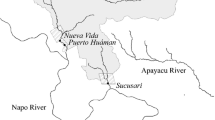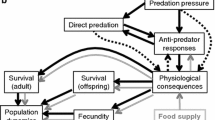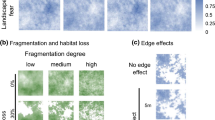Abstract
The risk of predation drives many behavioral responses in prey. However, few studies have directly tested whether predation risk alters the way other variables influence prey behavior. Here we use information theory (Akaike’s Information Criterion, AICc) in a novel way to test the hypothesis that the decision-making rules governing elk behavior are simplified by the presence of wolves. With elk habitat use as the dependent variable, we test whether the number of independent variables (i.e., the size of the models) that best predict this behavior differ when wolves are present vs absent. Thus, we use AICc scores simply to determine the number of variables to which elk respond when making decisions. We measured habitat use using 2,288 locations from GPS collars on 14 elk, over two winters (14 elk winters), in the Gallatin Canyon portion of the Greater Yellowstone Ecosystem. We found that the use of three major habitat components (grass, conifer, sage) was sensitive to many variables on days that wolves were locally absent, with the best models (ΔAICc≤2) averaging 7.4 parameters. In contrast, habitat use was sensitive to few variables on days when wolves were present: the best models averaged only 2.5 parameters. Because fewer variables affect elk behavior in the presence of wolves, we conclude that elk use simpler decision-making rules in the presence of wolves. This simplification of decision-making rules implies that predation risk imposes selection pressures that do not allow prey to respond to other pressures in ways that they otherwise would. If the affected processes are important, then this indirect effect of predation is likely to be important.


Similar content being viewed by others
References
Abramsky Z, Rosenzweig ML, Subach A (2002) The costs of apprehensive foraging. Ecology 83:1330–1349
Bergerud AT, Butler HE, Miller DR (1983) Antipredator tactics of calving caribou: dispersion in mountains. Can J Zool 62:1566–1575
Blumstein DT, Daniel JC (2002) Isolation from mammalian predators differentially affects two congeners. Behav Ecol 13:657–663
Brazda AR (1953) Elk migration patterns, and some of the factors affecting movements in the Gallatin River drainage, Montana. J Wildl Manage 17:9–23
Burnham KP, Anderson DR (2002) Model selection and multimodel inference: a practical information-theoretic approach, 2nd edn. Springer, Berlin Heidelberg New York
Christianson D, Creel S (2006) A review of environmental factors affecting elk winter diets. J Wildl Manage (in press)
Cook JG (2002) Nutrition and food. In: Toweill DE, Thomas JW (eds) North American elk, ecology and management. Smithsonian Institution Press, Herndon, Virginia
Creel S, Winnie J Jr (2005) Responses of elk herd size to fine-scale spatial and temporal variation in the risk of predation by wolves. Anim Behav 69:1181–1189
Creel S, Winnie J Jr, Maxwell B, Hamlin K, Creel M (2005) Elk alter habitat selection as an antipredator response to wolves. Ecology 86(12):3387–3397
Demarchi R (1968) Chemical composition of bighorn winter forages. J Range Manag 21(9):385–388
Elgar MA (1989) Predator vigilance and group size in mammals and birds: a critical review of the empirical evidence. Biological Review 64:13–33
Formanowicz DR, Bobka MS (1988) Predation risk and microhabitat preference: an experimental study of the behavioral responses of prey and predator. Am Midl Nat 121:379–386
Geist V (2002) Adaptive and behavioral strategies. In: Toweill DE, Thomas JW (eds) North American elk, ecology and management. Smithsonian Institution Press, Herndon, Virginia
Heithaus MR, Dill LM (2002) Food availability and tiger shark predation risk influence bottlenose dolphin habitat use. Ecology 83:480–491
Hudson RJ, Haigh JC, Bubenik AB (2002) Physical and physiological adaptations. In: Toweill DE, Thomas JW (eds) North American elk, ecology and management. Smithsonian Institution Press, Herndon, Virginia
Hughes JJ, Ward D (1993) Predation risk and distance to cover affect foraging behaviour in Namib Desert gerbils. Anim Behav 46:1243–1245
Hutchinson JMC, Gigerenzer G (2005) Connecting behavioural biologists and psychologists: clarifying distinctions and suggestions for further work. Behav Processes 69:159–163
Illius AW, Fitzgibbon C (1994) Costs of vigilance in foraging ungulates. Anim Behav 47:481–484
Jenkins KJ, Wright RG (1987) Dietary niche relationships among cervids relative to winter snowpack in northwestern Montana. Can J Zool 65:1397–1401
Jones PF, Hudson RJ, Farr DR (2001) Evaluation of a winter habitat suitability index model for elk in west-central Alberta. For Sci 48(2):417–425
Kemp S (2005) Simple optimisation. Behav Processes 69:131–132
Kipling R (1902) Just so stories. MacMillan, London
Lima SL, Dill LM (1990) Behavioral decisions made under the risk of predation: a review and prospectus. Can J Zool 68:619–640
Merrill EH (1991) Thermal constraints on use of cover types and activity time of elk. Appl Anim Behav Sci 29:251–267
Morgantini LE, Hudson RJ (1985) Changes in diets of Wapiti during a hunting season. J Range Manag 38:77–79
Peek JM, Lovaas AL (1968) Differential distribution of elk by sex and age on the Gallatin winter range, Montana. J Wildl Manage 32:553–565
Peek JM, Lovaas AL, Rouse RA (1967) Population changes within the Gallatin elk herd, 1932–65. J Wildl Manage 31:304–316
Rew LJ, Maxwell BD, Aspinall R (2005) Predicting the occurrence of nonindigenous species using environmental and remotely sensed data. Weed Sci 53:236–241
Rew LJ, Maxwell BD, Dougher FL, Aspinall R (2006) Searching for a needle in a haystack: evaluating survey methods for non-indigenous plant species. Biological Invasions Special Issue 8(3):523–539
Sih A, McCarthy TM (2002) Prey responses to pulses of risk and safety: testing the risk allocation hypothesis. Anim Behav 63:437–443
Sih A, Krupa J, Travers S (1990) An experimental study on the effects of predation risk and feeding regime on the mating behavior of the water strider. Am Nat 135:284–290
Stephens PA, Buskirk SW, Hayward GD, Martinez Del Rio C (2005) Information theory and hypothesis testing: a call for pluralism. J Appl Ecol 42:4–12
Sweeney JM, Sweeney JR (1984) Snow depths influencing winter movements of elk. J Mammal 65(3):524–526
Winnie J Jr, Creel S (2006) Sex specific behavioral responses of elk to the threat of wolf predation. Anim Behav (in press)
Author information
Authors and Affiliations
Corresponding author
Additional information
Communicated by P. Bednekoff
Rights and permissions
About this article
Cite this article
Winnie, J., Christianson, D., Creel, S. et al. Elk decision-making rules are simplified in the presence of wolves. Behav Ecol Sociobiol 61, 277–289 (2006). https://doi.org/10.1007/s00265-006-0258-1
Received:
Revised:
Accepted:
Published:
Issue Date:
DOI: https://doi.org/10.1007/s00265-006-0258-1




